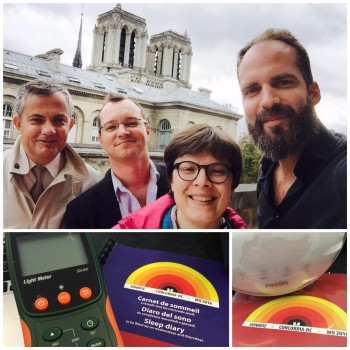ESA-sponsored medical doctor Floris van den Berg, now in Antarctica, recounts on his blog his visits to the researchers whose experiments he will run at Concordia research station.
‘Sunrise, sunrise
Looks like mornin’ in your eyes,
But the clocks held 9:15 for hours
Sunrise, sunrise’Norah Jones – 2004
I’m pretty sure Norah Jones never visited Concordia station, and if she has, probably not during the Antarctic winter, where, unlike in her song, the Sun does not always rise.
9:30 on a Friday morning, I met the ‘Sunrise Team’ for the first time at the Hotel Dieu Hospital right next to Notre Dame in Paris. For this team I will be studying and testing the efficiency of dawn and dusk simulation (Wake-Up Lights) as a counter-measure to the adverse effects of the Antarctic night on sleep and mood. What better place to test these lamps than in complete darkness?!
In my normal daily life, my days start either before it’s light or after with only minimal variations related to my working hours and/or the seasons. At the Concordia Station, which is located within the Antarctic circle, these ‘normal’ options will no longer exist for me…
During ‘summer’ time, the sun shines 24 hours a day. It would be perfect for tanning, except for the fact that the average summer temperature is only -30 Celcius. It also means that during the Antarctic winter, the sun does not rise for over 3 months! Good if you’re a bat and love the dark, but bats don’t cope so well with the unbelievable -80 Celsius the winter can bring.
Besides being the dream workplace for every astronomer (days with 24 hours to look at the stars!!), Concordia becomes even more extreme during the months of darkness. Human beings often have trouble coping without the sense of time that natural light provides. Sleeping problems and psychological problems often occur. These problems are called Seasonal Affective Disorders or Winter Depressions.
The Sunrise study will be monitoring for these problems and determine if the wake-up lights are effective. Using special light sensors in all the rooms of the winter-over team, we will measure the light exposure and timings. This data will then be compared to the results of questionnaires about sleep and mood, and the total sleep time will also be measured with the Acti-watches from the Neurocog study. It will be interesting to see how everyone is feeling, especially when the first sun rises after 3 months of darkness, stay tuned to listen to ‘Sunrise’ at the first sunrise!
Head researchers I met: Damien Leger, Amaury Solignac, Marion Trousselard & Charlotte Poupon
Official research title: SUNRISE






Discussion: no comments